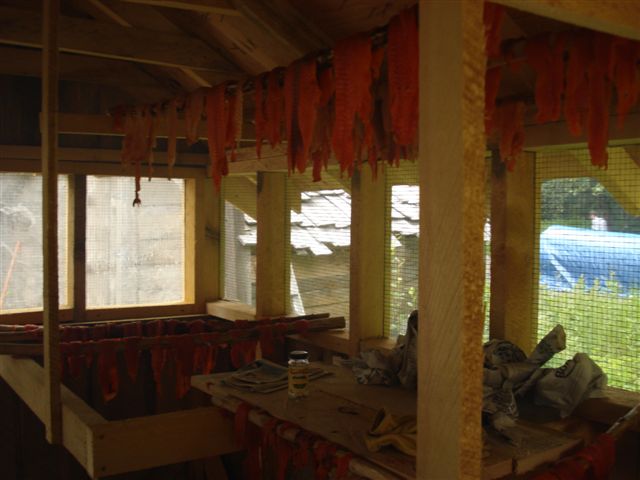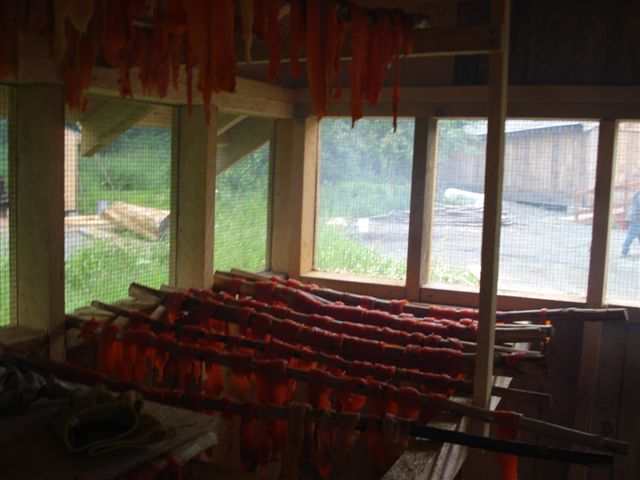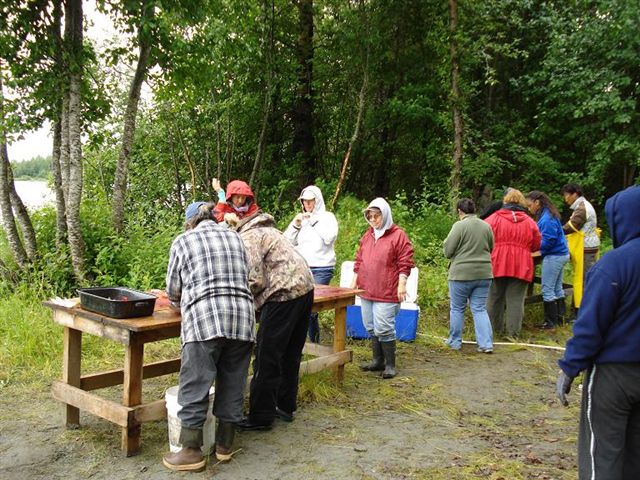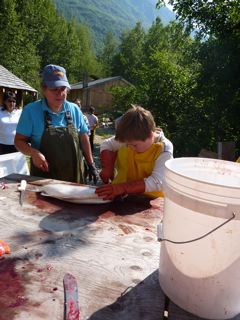 The Camp is used to instruct tribal members and visitors of all ages in subsistence skills including demonstrations of traditional fish and moose processing methods.
The Camp is used to instruct tribal members and visitors of all ages in subsistence skills including demonstrations of traditional fish and moose processing methods.
Perpetuation of subsistence lifestyle skills and traditional fine arts are the main focus of the Klukwan Traditional Knowledge Camp. For many years the Tlingit people, as well as other Alaska Native peoples, underwent cultural oppression at many different levels – in the schools, government, churches, and even the market place. These years of oppression injured the psyche and emotional health of natives. By returning to our cultural roots, through the activities of the Klukwan Traditional Knowledge Camp, local natives have found healing and wellness in body, soul, and spirit. The Camp and wellness movement in Klukwan has been an inspiration to other communities in Southeast Alaska and beyond.
 The movement towards our cultural roots was evident with the creation of the Klukwan Traditional Knowledge Camp. Construction of the camp began in 2002 when a group of local men, working only with wedges, and mauls began splitting planks off of local spruce logs to create the lumber needed to build a traditional smoke house.
The movement towards our cultural roots was evident with the creation of the Klukwan Traditional Knowledge Camp. Construction of the camp began in 2002 when a group of local men, working only with wedges, and mauls began splitting planks off of local spruce logs to create the lumber needed to build a traditional smoke house.
The building of the smoke house was a learning experience as this type of construction had not been practiced locally for at least 100 years. Once the planks were split from the logs they were smoothed and shaped with traditional adzes and laid aside until enough were stockpiled to begin actual construction. The smoke house was only the beginning. In the summer of 2004, the crew completed construction on a 35′ X 50′ traditional long house. The long house was given the name: “Kaaya Haayi Hit” by a local elder. The camp currently consists of a smokehouse, long house, drying shed, and an adzing shed.
Seasonal Klukwan Traditional Knowledge Camps include demonstrations of traditional salmon harvesting, moose preparation, and hooligan processing with Tlingit language and cultural instruction integrated in each of the activities. Salmon is prepared for smoking, drying and more modern techniques such as pressure processing. Hooligan harvest techniques have also been taught, smoke/drying, and the rendering of oil. Moose butchering, preparing a moose bone stock and a traditional stew, and more contemporary skills such as grinding meat, sausage making, and pressure processing of meat in jars are some of the activities of the moose camp. Traditional hide tanning and other fine arts such as carving, basket weaving, Chilkat/Ravenstail Weaving and sewing/beading are some additional activities of the camp.
When the Village is not hosting the seasonal subsistence skills camps the campsite is used as a cultural interpretive center for visitors to Klukwan through Klukwan Tribal Tours.
Related Links
The following agencies and organizations have assisted in the setup and operation of the Traditional Knowledge Camps:
- University of Alaska Southeast
- Southeast Alaska Regional Health Consortium
- Sealaska Heritage Institute
- Alaska Humanities Forum Rose Rural Urban Exchange
Fine Arts Camps
Traditional hide tanning and other fine arts such as carving, basket weaving, Chilkat/Ravenstail Weaving and sewing/beading are some activities of the Fine Arts camp.
 |
 |
Moose Camp
Moose butchering, preparing a moose bone stock and a traditional stew, and more contemporary skills such as grinding meat, sausage making, and pressure processing of meat in jars are some of the activities of the moose camp.
Salmon Camp
Seasonal Klukwan Traditional Knowledge Camps include demonstrations of traditional salmon harvesting and hooligan processing. Salmon is prepared for smoking, drying and more modern techniques such as pressure processing. Hooligan harvest techniques are also taught, smoke/drying, and the rendering of oil.
There are 2 salmon camps. One in July and one in August.
 |
 |
 |
 |
 |
 |
 |
 |
Tlingit Language Camps
Another area of focus has been in the area of language restoration. The Tlingit language is a very important ingredient for maintaining our cultural identity yet there are very few adults under the age of sixty who speak Tlingit. For the past 10 years the Tlingit Language has been taught at Klukwan School. In 2003 the village received a Language Restoration Grant from the Administration for Native Americans. With this grant the Village Language Staff developed a community wide language restoration program. The curriculum created through the language restoration grant is currently being used as part of the training for local tour guides. Guides will be expected to incorporate as much Tlingit Language into their interpretive presentations as practicable.
In 2003 the village received a Language Restoration Grant from the Administration for Native Americans. With this grant the Village Language Staff developed a community wide language restoration program. The curriculum created through the language restoration grant is currently being used as part of the training for local tour guides. Guides will be expected to incorporate as much Tlingit Language into their interpretive presentations as practicable.
We currently also have a three year Department of Education Alaska Native Education Program Grant (2006 – 2009) in place.
Tlingit Language Phrases, Colors and Introductions
We are please to present a series of examples of colors, phrases and introductions with translations and sound clips.
Related Links
- Sealaska Heritage Institute
Seeks to perpetuate and enhance Tlingit, Haida and Tsimshian Cultures
